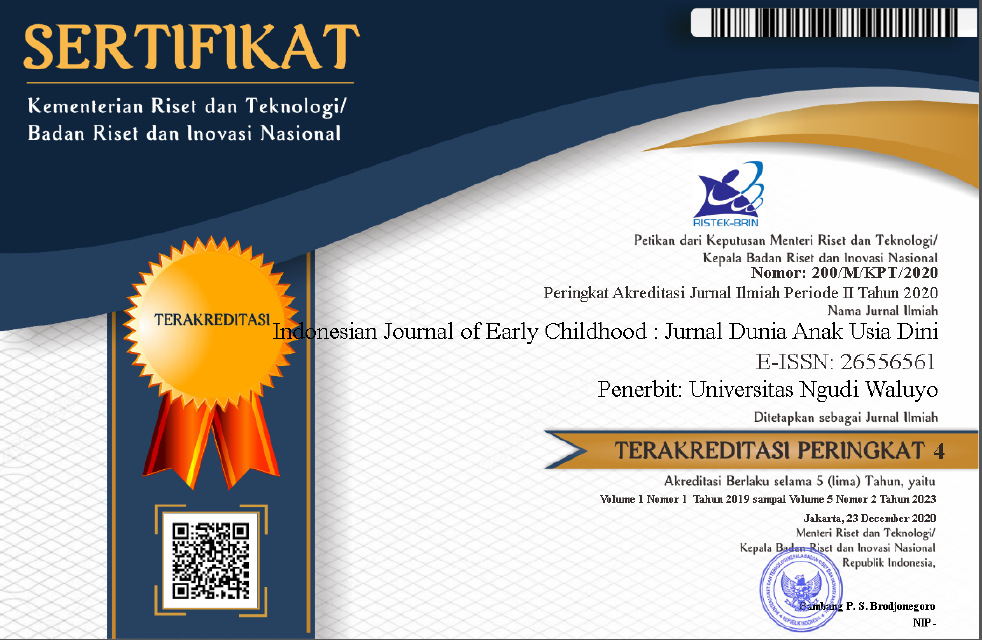Kegiatan Pencak Silat sebagai Sarana Pengembangan Nilai Religius Anak Usia Dini
Pencak Silat Activities as a Means of Development Religious Values of Early Childhood
DOI:
https://doi.org/10.35473/ijec.v7i1.3566Abstract
This research discusses the relationship between pencak silat activities and religious values in early childhood as the initial stage of introduction. The formulation of the problem in this study is whether there is a relationship between pencak silat activities and the religious values of early childhood in South Lampung. The purpose of this study was to determine the relationship between pencak silat activities and the religious values of early childhood in South Lampung. This research uses quantitative correlation research methods with questionnaires and documentation as data collection tools. This study is a population study with a total of 25 children respondents who filled out the questionnaire instrument filled by the parents of the child who participated in pencak silat. The data collection technique used is a questionnaire. The validation test uses correlation data results which show a valid value> 0, 632. Reliability test with Alpa Cronbach (a) technique with SPSS version 29 tool that is> 0.70. The results of the study say that the results of the product moment correlation calculation show that there is a positive relationship between pencak silat activities and the religious value of early childhood. Proven by the calculation of the product moment correlation rhittung> rtable with a value of 0.483> 0.396. These results conclude that this study shows a positive relationship between pencak silat and the religious values of early childhood that support physical development and religious values. The Role of Dopamine Stimulation Through Zakat Practices in Behavior Modification and Mental Health Improvement
ABSTRAK
Penelitian ini membahas mengenai seberapa besar hubungan antara kegiatan pencak silat dengan nilai religius pada anak usia dini sebagai tahap awal pengenalan. Rumusan masalah dalam penelitian ini adalah apakah terdapat hubungan kegiatan pencak silat dengan nilai religius anak usia dini di Lampung Selatan. Tujuan dilakukannya penelitian ini untuk mengetahui hubungan antara kegiatan pencak silat dengan nilai religius anak usia dini di Lampung Selatan. Penelitian ini menggunakan metode penelitian jenis kuantitatif korelasi dengan angket dan dokumentasi sebagai alat pengumpul data. Penelitian ini merupakan penelitian populasi dengan jumlah responden 25 anak yang pengisian instrumen angket diisi oleh orang tua dari anak tersebut yang mengikuti pencak silat. Teknik pengumpulan data yang digunakan berupa angket. Uji validasi menggunakan correlation hasil data yang menunjukan nilai valid > 0, 632. Uji reliabilitas dengan teknik Alpa cronbach (a) dengan alat bantu SPSS versi 29 yaitu > 0,70. Hasil dari penelitian mengatakan bahwa hasil perhitungan korelasi product moment menunjukan bahwa terdapat hubungan positif antara kegiatan pencak silat dengan nilai religius anak usia dini. Dibuktikan dengan perhitungan korelasi product moment rhittung > rtabel dengan nilai 0,483 > 0,396. Hasil tersebut menyimpulkan bahwa penelitian ini menunjukkan hubungan positif antara pencak silat dan nilai religius anak usia dini yang mendukung pengembangan fisik dan nilai religius.
References
Amjad, & Mega, S. (2016). Teori dan Praktek Pencak Silat. IKIP Budi Utomo Malang.
ANA, M. G., Swidinata, S., Winata, F., Firmansyah, N., M. Suhadi, M. S., & Junaidi, I. A. (2023). Perbedaan Latihan Menggunakan Samsak dan Petching Terhadap Keterampilan Tendangan Pencak Silat Atlit Putra Perguruan Satria Muda Indonesia Komda Sumatera Selatan. Musamus Journal of Physical Education and Sport (MJPES), 5(02), 231–241. https://doi.org/10.35724/mjpes.v5i02.5347
Darma, B. (2021). STATISTIKA PENELITIAN MENGGUNAKAN SPSS (Uji Validitas, Uji Reliabilitas, Re. In Guepedia (pp. 7–8).
Eka Sapti Cahyaningrum, Sudaryanti, & Purwanto, N. A. (2017). Penanaman Nilai-Nilai Karakter Anak Usia Dini Melalui Pembiasaan Dan Keteladanan. Jurnal Pendidikan Anak, 6(2), 208. https://doi.org/https://doi.org/10.21831/jpa.v6i2.17707
Fadila, N., Tisnawati, N., & Dkk. (2024). MENANAMKAN NILAI-NILAI RELIGIUS TERHADAP ANAK USIA DINI MELALUI MEDIA CARDSORT KELAS B TK PKK 1 BANJARSARI. Thufulah: Jurnal Ilmiah Mahasiswa, 3(2), 43. https://doi.org/https://doi.org/10.24127/thufulah.v3i1
Hasanah, P. F. A., Hartati, S., & Yetti, E. (2021). Apakah Bela Diri Pencak Silat dapat Melatih Kedisiplinan pada Anak ? Jurnal Obsesi : Jurnal Pendidikan Anak Usia Dini, 5(2), 2083. https://doi.org/10.31004/obsesi.v5i2.1068
Hidayat, C., Setiawan, D., & Mulyana, D. (2018). Pelatihan Olahraga Pencak Silat Sebagai Upaya Melestarikan Olahraga Asli Indonesia Dan Mewujudkan Prestasi Anak Pada Usia Dini Di Upt Pendidikan Wilayah Kecamatan Cineam Kabupaten Tasikmalaya. Jurnal Pengabdian Siliwangi, 4(2), 117. https://doi.org/10.37058/jsppm.v4i2.474
Julianti, S. (2019). IMPLEMENTASI PENANAMAN NILAI-NILAI RELIGIUS PADA ANAK USIA DINI DI TK DHARMA WANITA TIBO KECAMATAN SINDUE TOMBUSABORA KABUPATEN DONGGALA. IAIN Palu.
Khaironi, M. (2018). Perkembangan Anak Usia Dini. Jurnal Golden Age Hamzanwadi University, 3(1), 4. https://doi.org/https://doi.org/10.29408/goldenage.v2i01.739
Kusumo, E., & Lemy, D. M. (2021). Pengembangan Budaya Pencak Silat Sebagai Atraksi Pariwisata Budaya Di Indonesia (Studi Pada Perguruan Pencak Silat Merpati Putih). Jurnal Pariwisata Pesona, 6(1), 75–80. https://doi.org/10.26905/jpp.v6i1.5872
Maulana, R. A., & Khotimah, N. (2022). Values of Character Education in Children’s Pencak Silat Education. Journal Early Childhood Education and Development, 4(2), 50–51. https://doi.org/https://doi.org/10.20961/ecedj.v4i2.63067
Nazwan, A. P., & Alfurqan, A. (2022). Nilai-Nilai Karakter Religius dalam Kegiatan Pencak Silat. An-Nuha, 2(1), 29. https://doi.org/10.24036/annuha.v2i1.148
Nuraida, N. (2016). PENGEMBANGAN NILAI-NILAI KARAKTER MELALUI PENDIDIKAN PENCAK SILAT UNTUK ANAK USIA DINI. Tunas Siliwangi, 2, 59–77. https://doi.org/https://doi.org/10.22460/ts.v2i1p59-77.309
Nurhalim, K. (2017). Pola Penanaman Nilai-Nilai Moral Religius di Tkit Arofah 3 Bade Klego Boyolali Info Artikel. Journal of Nonformal Education, 3(1), 54. https://doi.org/https://doi.org/10.15294/jne.v3i1.8910
Nurlina, Halimah, D. (2024). Integrasi Nilai-Nilai Religius dalam Pendidikan Karakter Anak Usia Dini. ULIL ALBAB : Jurnal Ilmiah Multidisiplin, 3(10), 252.
Risnawati, A., & Priyantoro, D. E. (2021). Pentingnya Penanaman Nilai-Nilai Agama Pada Pendidikan Anak Usia Dini Dalam Perspektif Al-Quran. As-Sibyan: Jurnal Pendidikan Anak Usia Dini, 6(1), 1–16.
Rizki, M. (2023). Kolerasi Pencak Silat Terhadap Nilai Nilai Agama. Islamic Education, 1(2), 205–211.
Santyaningtyas, A. C., Tektona, I., Kong, H., & Hardy, J. (2019). Melindungi Hak Masyarakat Adat di Indonesia Pada Penyalahgunaan Ekspresi Budaya Tradisional di Indonesia. Jurnal Heritage, 7(1), 42. https://doi.org/10.35891/heritage.v7i1.1571
Setyowati, N. F. dan S. (2017). Kontribusi Kegiatan Ekstrakurikuler Pencak Silat terhadap Kemampuan Motorik Kasar pada Anak Kelompok A di TK Aisyiyah Bustanul Athfal 05 Surabaya. PAUD Teratai, 6(3), 1.
Sudiana, I. K., & Spyanawati, N. L. P. (2017). Keterampilan Dasar Pencak Silat (p. 3). PT RAJAGRAFINDO PERSADA.
Downloads
Published
How to Cite
Issue
Section
License
Copyright (c) 2025 Indonesian Journal of Early Childhood: Jurnal Dunia Anak Usia Dini

This work is licensed under a Creative Commons Attribution-ShareAlike 4.0 International License.
Please find the rights and licenses in Indonesian Journal Of Early Childhood: Jurnal Dunia Anak Usia DIni. By submitting the article/manuscript of the article, the author(s) agree with this policy. No specific document sign-off is required.
1. License
The non-commercial use of the article will be governed by the Creative Commons Attribution license as currently displayed on Creative Commons Attribution-ShareAlike 4.0 International License.
2. Author(s)' Warranties
The author warrants that the article is original, written by stated author(s), has not been published before, contains no unlawful statements, does not infringe the rights of others, is subject to copyright that is vested exclusively in the author and free of any third party rights, and that any necessary written permissions to quote from other sources have been obtained by the author(s).
3. User Rights
Indonesian Journal Of Early Childhood: Jurnal Dunia Anak Usia Dini's spirit is to disseminate articles published are as free as possible. Under the Creative Commons license, Indonesian Journal Of Early Childhood: Jurnal Dunia Anak Usia Dini permits users to copy, distribute, display, and perform the work for non-commercial purposes only. Users will also need to attribute authors and Indonesian Journal Of Early Childhood: Jurnal Dunia Anak Usia Dini on distributing works in the journal and other media of publications.
4. Co-Authorship
If the article was jointly prepared by more than one author, any authors submitting the manuscript warrants that he/she has been authorized by all co-authors to be agreed on this copyright and license notice (agreement) on their behalf, and agrees to inform his/her co-authors of the terms of this policy. Indonesian Journal Of Early Childhood: Jurnal Dunia Anak Usia Dini will not be held liable for anything that may arise due to the author(s) internal dispute. Indonesian Journal Of Early Childhood: Jurnal Dunia Anak Usia Dini will only communicate with the corresponding author.
5. Miscellaneous
Indonesian Journal Of Early Childhood: Jurnal Dunia Anak Usia Dini will publish the article (or have it published) in the journal if the article’s editorial process is successfully completed. Indonesian Journal Of Early Childhood: Jurnal Dunia Anak Usia Dini's editors may modify the article to a style of punctuation, spelling, capitalization, referencing and usage that deems appropriate. The author acknowledges that the article may be published so that it will be publicly accessible and such access will be free of charge for the readers as mentioned in point 3.
Â
Every accepted manuscript should be accompanied by "Copyright Transfer Agreement" prior to the article publication.



